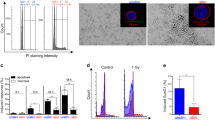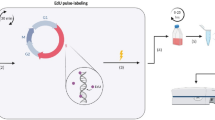Summary
CHO cells were exposed in vitro for 1 h to concentrations of 0.1–20 μg/ml of the cytostatic drug epirubicin. Population growth, survival fractions, cell-cycle-phase distribution, and BrdU incorporation were analyzed. A fraction of the cells showed a transitory cytostatic reaction at 1 μg/ml, and >99% of the cells were killed at 10 μg/ml. The survival curve was biphasic with a steep slope at concentrations of up to 5 μg/ml. Approximately 0.1% of the cells were resistant to higher concentrations of epirubicin. Bivariate DNA/BrdU flow cytometry revealed that the sensitive cells were blocked and probably killed in the G2M phase of the cell cycle.
Similar content being viewed by others
References
Altavilla G, Adamo V, Alafaci E, Buemi B, Caristi B, Condemi G, Toscano G (1989) VP16, epirubicin and procarbazine in the treatment of advanced non-small-cell lung cancer. Tumori 51: 168
Baranco SC (1975) Review of the survival and cell kinetic effects of Adriamycin (NSC-123 127) on mammalian cells. Cancer Chemother Rep 6: 147
Baranco SC (1986) Cellular and molecular effects of Adriamycin on dividing and nondividing cells. In: Dethlefsen LA (ed) Cell cycle effect of drugs. Pergamon, Oxford, p 251
Bradley G, Juranka PF, Ling V (1988) Mechanism of multidrug resistance. Biochim Biophys Acta 948: 87
Braunschweiger PG, Schiffer LM (1980) Effect of Adriamycin on the cell kinetics of 13 762 rat mammary tumors and implications for therapy. Cancer Treat Rep 64: 3812
Cantoni O, Sestili P, Cattabeni F, Geroni C, Grandi M, Giuliani FC (1989) Cellular and molecular pharmacology of 4′-epidoxorubicin in HeLa cells. J Cancer Res Clin Oncol 115: 373
Cantoni O, Sestili P, Cattabeni F, Geroni C, Giuliani F (1990) Comparative effects of doxorubicin and 4′-epidoxorubicin on nucleic acid metabolism and cytotoxicity in a human tumor cell line. Cancer Chemother Pharmacol 27: 47
Gundersen S, Kvinnsland S, Klepp O, Lund E, Hst H (1990) Weekly Adriamycin registered vs 4-epidoxorubicin every second week in advanced breast cancer. A randomized trial. Eur J Cancer 26: 45
Heidemann E, Steinke B, Hartlapp J, Schumacher K, Possinger, Kunz S, Neeser E, Ingersleben G von, Hossfeld D, Waldmann R (1990) Randomized clinical trial comparing mitoxantrone with epirubicin and with doxorubicin, each combined with cyclophosphamide in the first-line treatment of patients with metastatic breast cancer. Onkologie 13: 24
Hemmer J (1990) Rapid in vitro bromodeoxyuridine labeling method for monitoring of therapy response in solid human tumors. Cytometry 11: 603
Kaye S, Merry S (1985) Tumour cell resistance to anthracyclines: a review. Cancer Chemother Pharmacol 14: 96
Kimler BF, Cheng CC (1982) Comparison of the effects of dihydroxyanthraquinone and Adriamycin on the survival of cultured Chinese hamster cells. Cancer Res 42: 3631
Kretzschmar A, Drings P (1990) Epirubicin weekly in combination chemotherapy with cyclophosphamide and vincristine in untreated small cell lung cancer. Onkologie 13: 141
Lopez M, Natali M, Lauro L di, Tonini G, Carpano S, Vici P, Conti EM (1990) 5-Fluorouracil, epirubicin, and BCNU (FEB) in advanced measurable gastric cancer. Am J Clin Oncol 13: 204
Roth A, Zupanc D, Luetic J, Kaloric K (1990) Open phase II with 5-fluorouracil, 4′epidoxorubicin and mitomycin C (FEM) in advanced gastric cancer. Tumori 75: 51
Tobey RA, Chrissman HA, Oka MS (1976) Arrested and cycling CHO cells as a kinetic model: studies with Adriamycin. Cancer Treat Rep 60: 1829
Toma S, Coialbu T, Biassoni L, Folce U, Gatti C, Canavese G, Giacchero A, Rosso R (1990) Epidoxorubicin plus ifosfamide in advanced and/or soft-tissue sarcoma. Cancer Chemother Pharmacol 26: 453
Torti FM, Bristow MM, Lum BL, Carter SK, Howes AE, Aston DA, Brown BW, Hannigan JF, Meyers FJ, Mitchell EP (1986) Cardiotoxicity of epirubicin and doxorubicin: assessment by endomyocardial biopsy. Cancer Res 46: 3722
Van der Vijgh WJF, Maessen PA, Pinedo HM (1990) Comparative metabolism and pharmacokinetics of doxorubicin and 4′-epidoxorubicin in plasma, heart and tumor of tumor-bearing mice. Cancer Chemother Pharmacol 26: 9
Zante J, Schumann J, Barlogie B, Göhde W, Büchner T (1976) New preparation and staining procedure for specific and rapid analysis of DNA distribution. In: Göhde W, Schumann J, Büchner T (eds) Pulse cytophotometry. European Press Medica, Ghent, p 97
Author information
Authors and Affiliations
Rights and permissions
About this article
Cite this article
Bartkowiak, D., Hemmer, J. & Röttinger, E. Dose dependence of the cytokinetic and cytotoxic effects of epirubicin in vitro. Cancer Chemother. Pharmacol. 30, 189–192 (1992). https://doi.org/10.1007/BF00686310
Received:
Accepted:
Issue Date:
DOI: https://doi.org/10.1007/BF00686310




